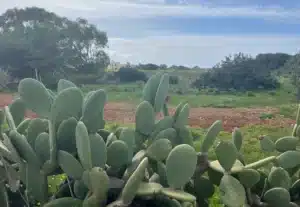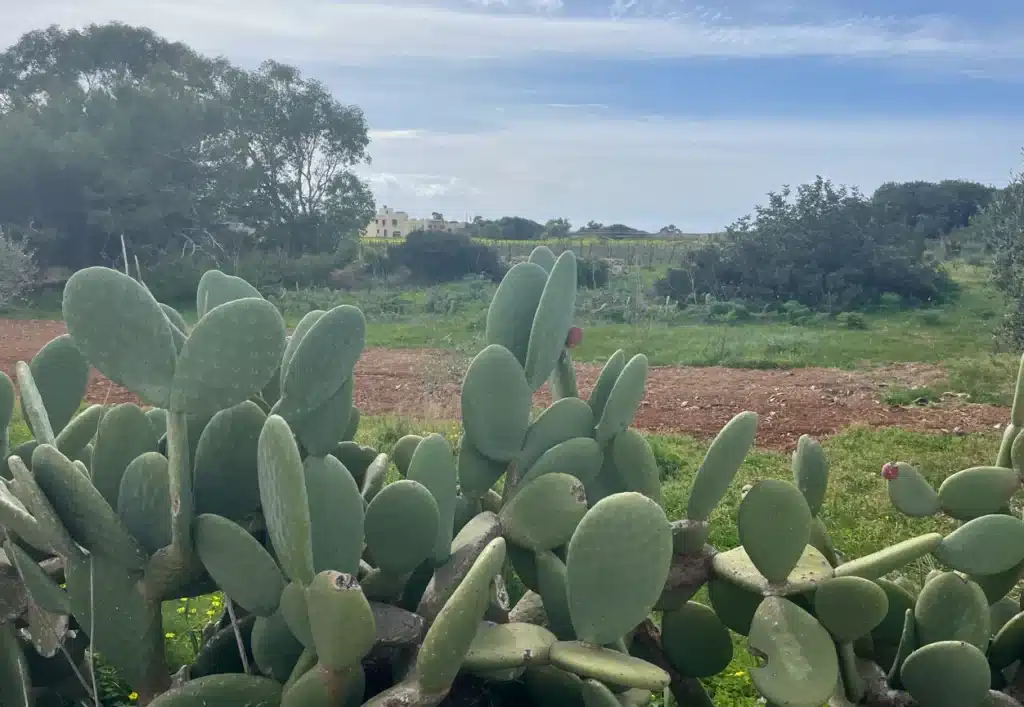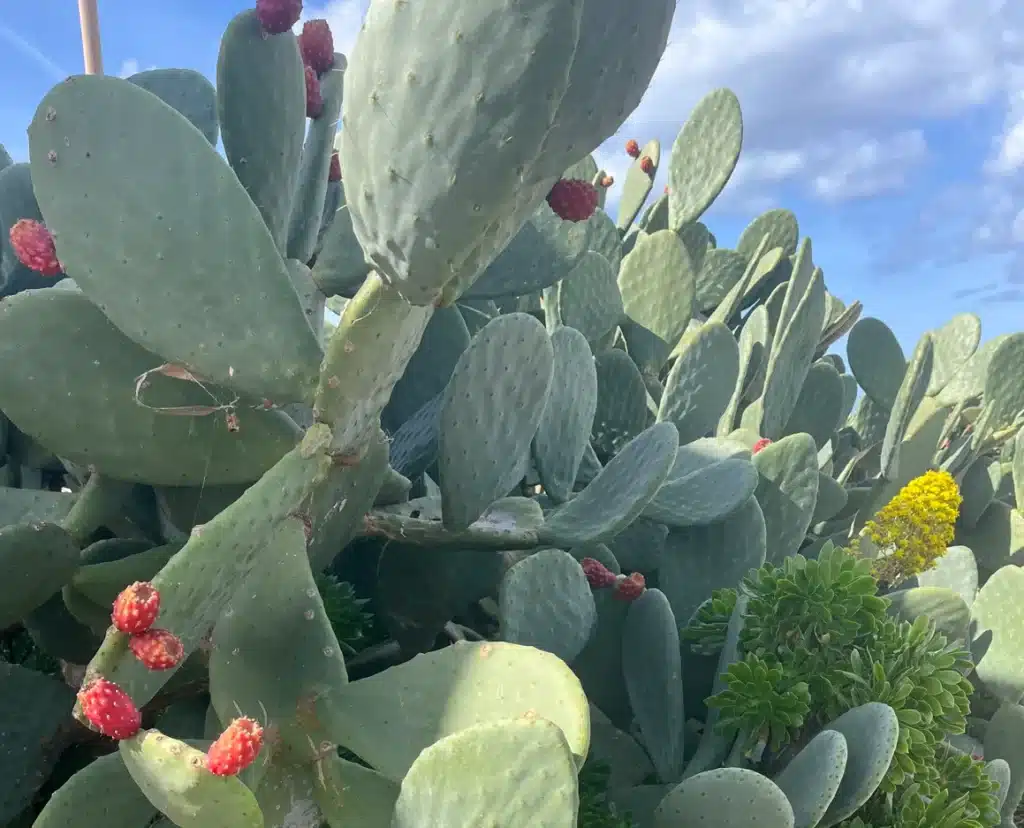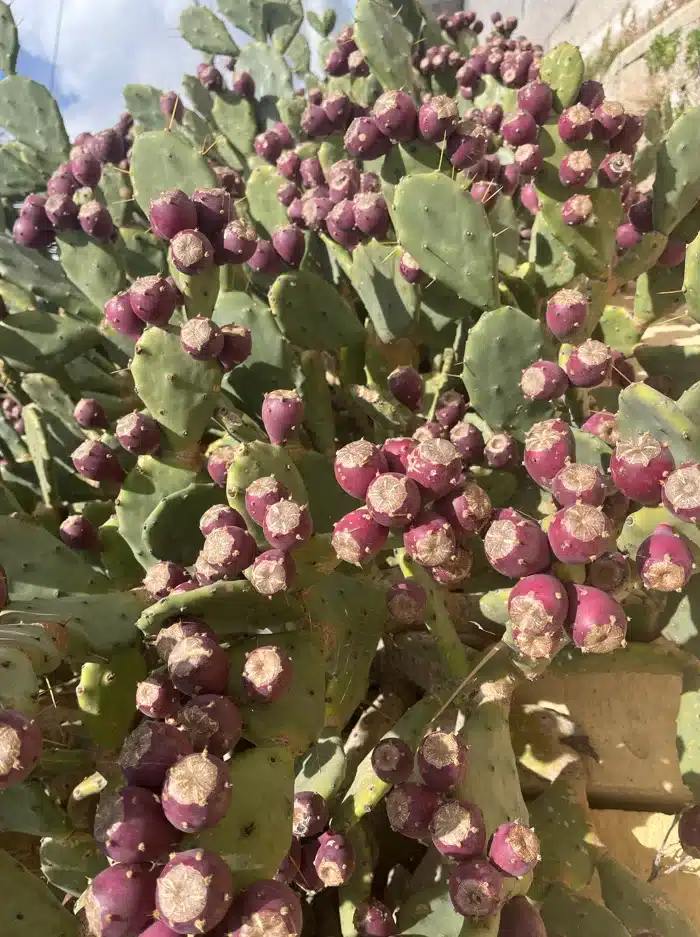
FAQ - Opuntia - Prickly Pear
Most frequent questions and answers
Absolutely! Opuntia species are generally low-maintenance plants that thrive on neglect.
You bet! Just be sure to provide them with plenty of sunlight and well-draining soil.

Opuntia hedge
- Opuntia or Prickly Pear
- Opuntia spp.
- Cactaceae
- Cactus
- 1 to 10 feet
- Full sun
- Well-draining, sandy or rocky
- Slightly acidic to alkaline
- Spring to summer
- Yellow, orange, red, or pink
- 3 to 11
- North and South America
Opuntia species, or Prickly pear cacti is a very popular Cactaceae family with over 200 recognized species. Opuntia cacti is renowned for their unique appearance and resilience in harsh environments. They usually thrive in arid and semiarid regions with periods of prolonged drought. Prickly pears are native to the Americas, spanning from the southwestern United States to South America. But can also be found in southern Europe where they have were introduced and popularized.
Opuntia species thrive in bright, direct sunlight, so it’s essential to place them in a spot where they can soak up the rays for at least six hours a day. In my experience, a south-facing window or a sunny patio is ideal for these sun-loving succulents. Just be sure to protect them from intense midday sun, as too much heat can scorch their delicate pads.
Opuntia cacti cies are not too picky when it comes to soil, but they do appreciate good drainage. In my experience, a well-draining cactus mix works wonders for these prickly plants. You can also mix in some sand or perlite to improve drainage further. Just be sure to avoid heavy, water-retentive soils, as they can lead to root rot—a definite no-no in the world of Opuntia care!
Opuntia species are quite forgiving when it comes to water, thanks to their succulent nature. During the growing season, water them thoroughly but allow the soil to dry out completely between waterings. In the winter months, cut back on watering to prevent soggy soil, which can spell disaster for these desert dwellers.

Opuntia cactus with fruits
Opuntia can easily endure extreme temperatures, but they do have their limits. In my experience, they prefer warm, dry climates and can tolerate temperatures as low as 20°F (-6°C) if kept dry. However, prolonged exposure to frost can damage or even kill these hardy plants, so it’s best to bring them indoors during the winter months if you live in a cold climate.
However certain species of Prickly pear are extremely tolerant to cold temperature and can endure
Opuntia fragilis (Brittle Prickly Pear) hardiness – 30°F (-34°C).
Opuntia humifusa (Eastern Prickly Pear) hardiness -25 °F (-31.7 °C)
Opuntia polyacantha (Plains Prickly Pear) hardiness – 40 °F ( – 40 °C)
Opuntia macrocentra (Long-spined Prickly Pear) hardiness -7° F (- 12° C)
Opuntia phaeacantha (Tulip Prickly Pear) hardiness -29 °C (-20 °F)

Winter dormant Prickly Pear
Ah, the joys of potting and repotting—a plant parent’s never-ending cycle. In my experience, potting up your Opuntia species is a relatively straightforward process. Choose a pot with drainage holes and fill it with a well-draining cactus mix. Then, gently remove your plant from its current pot and place it in the center of the new pot, adding more soil around the roots as needed. Be sure not to bury the plant too deeply, as this can lead to rot. As for repotting, aim to do so every couple of years to refresh the soil and give your Opuntia room to grow.

Pruning Prickly pear species is relatively straightforward, thanks to their resilient nature. Simply use a pair of sharp, clean scissors or pruning shears to remove any dead, damaged, or overgrown pads. You can also trim back any unruly growth to maintain a neat and tidy appearance. Just be sure to wear thick gloves to protect your hands from those pesky spines!
Opuntia species can be propagated through several methods, including cuttings, division, and seeds. For cuttings:
Thankfully, the success rate is very high when sticking a cutting down in some soil and almost always establishes roots and starts to grow a new plant.
With a little luck and a lot of patience, you’ll soon be rewarded with a crop of adorable Opuntia seedlings!
Cultivating an Opuntia cactus with cutting is much easier and faster, but you will most likely have something almost everyone else already have. Although, if you grow from seeds, you have the chance to acquire rare seeds from eBay or other vendors that may be hard to come by as cuttings.
Ah, winter—the season of dormancy for many plants, including Opuntia species. Overwintering your Opuntia is all about providing the right conditions for a restful slumber. If you live in a cold climate, bring your plants indoors before the first frost hits, and place them in a bright, cool spot away from drafts. Water sparingly during this time, as the plant’s metabolic activity slows down. Come spring, your Opuntia will awaken from its winter nap refreshed and ready to grow!
Certain Opuntia species, as mentioned before, can tolerate extremely cold temperatures as long as they are kept dry. They don’t even need extra light in areas with dark winters. They simply enter dormancy during fall and wakes up in spring once the temperature and hours of sunlight starts to increase.
Once Opuntia enter dormancy, they shrink and get a wrinkly appearance. Instead of the usually erect posture, it now is hanging with many branches supporting themselves on the ground.
Did you know that some Opuntia species are edible and have been cultivated for thousands of years for their delicious fruit? Or that certain species have been used medicinally by indigenous cultures for their healing properties? It is pretty common that the local supermarket offer seasonal Opuntia fruits. The fruits often are covered with very small spines that are hard to see for the naked eye, until you touch one. Those small spines are removed when the Opuntia fruits arrive to the supermarket.
Opuntia cacti species are relatively pest and disease-resistant, thanks to their thick, waxy skin and spiny exterior. However, they are not immune to the occasional infestation or infection. Keep an eye out for common pests such as mealybugs and scale insects, as well as fungal diseases like root rot and powdery mildew. Prompt action and proper care are key to keeping your Opuntia healthy and thriving.
Keeping it drama-free involves keeping an eye out for uninvited guests like aphids and mealybugs. Treat them to a little insecticidal soap spa treatment. And don’t forget to create some airflow.
In my experience, getting your Opuntia to bloom requires a combination of patience and proper care. Provide your plant with plenty of sunlight, all year round! Keep an eye out for flower buds forming on the edges of the pads, and watch in awe as they burst into bloom in late spring or early summer.
You can often see massive clusters of Opuntia across very large areas flowering at the same time.
Some cmmon problems with owning an Opuntia cactus include overwatering, sunburn, and pests. Overwatering can lead to root rot, while excessive sun exposure can cause sunburn and discoloration of the pads. Keep an eye on your plant’s appearance and adjust your care routine accordingly to prevent and address any issues that may arise. Remember, a little vigilance goes a long way in the world of Opuntia care!
Absolutely! Opuntia species are generally low-maintenance plants that thrive on neglect.
You bet! Just be sure to provide them with plenty of sunlight and well-draining soil.